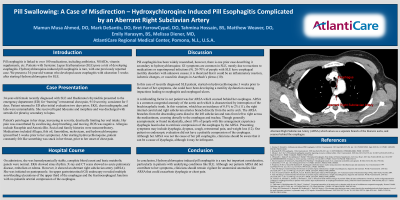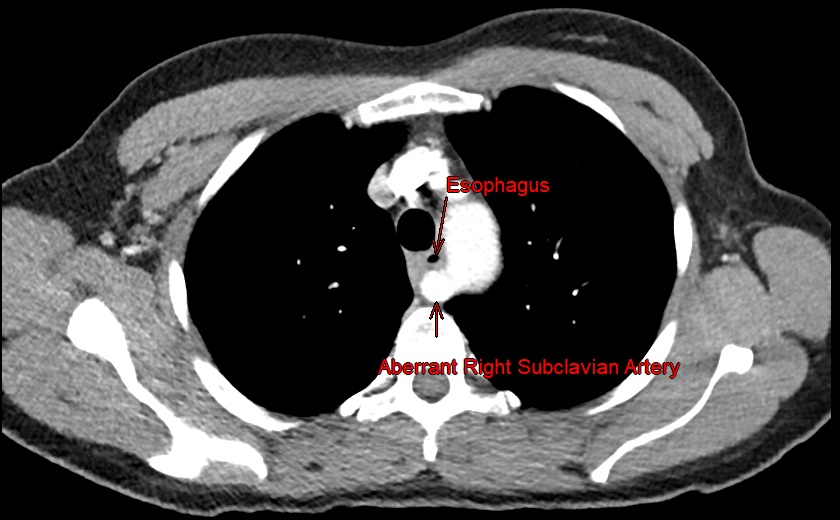Monday Poster Session
Category: Esophagus
P2323 - Pill Swallowing: A Case of Misdirection - Hydroxychloroquine Induced Pill Esophagitis Complicated by an Aberrant Right Subclavian Artery
Monday, October 28, 2024
10:30 AM - 4:00 PM ET
Location: Exhibit Hall E

Has Audio
- MA
Mamun Musa Ahmed, DO
Atlanticare Regional Medical Center
Atlantic City, NJ
Presenting Author(s)
Mamun Musa. Ahmed, DO1, Mark DeSantis, DO, MS2, Bret FarrowCypel, DO2, Tahmina Hossain, BS3, Matthew Weaver, DO2, Emily Harasym, BS4, Melissa Diener, MD2
1Atlanticare Regional Medical Center, Atlantic City, NJ; 2AtlantiCare Regional Medical Center, Atlantic City, NJ; 3New York University Langone Health, North Bellmore, NY; 4Geisinger Commonwealth School of Medicine, Atlantic City, NJ
Introduction: Antibiotics, NSAIDs, caffeine, and vitamins can cause pill esophagitis. Risk factors include pill size, fluid intake, esophageal motility, or altered anatomy. Hydroxychloroquine-induced pill esophagitis is rare with one prior report. We present a 34-year-old woman who developed acute esophagitis with ulceration three weeks after starting Hydroxychloroquine for SLE.
Case Description/Methods: A 34-year-old female recently diagnosed with SLE presented to the ED with severe retrosternal chest pain worsened by swallowing, breathing deeply, and movement. Patient initially developed this pain when she began taking Hydroxychloroquine three weeks prior and felt as if something was stuck in her throat. She initially presented to the ED two days prior with the same complaint, workup was unrevealing. Patient was given lidocaine and morphine for symptomatic relief and discharged on steroids for pleurisy. She returned with worsening pain. Initial tests showed no abnormalities. On admission, she was hemodynamically stable, labs, radiograph, and EKG were within normal limits. CT Chest with contrast revealing an anomalous origin of the right subclavian artery which arises as a separate branch of the thoracic aorta and courses behind the esophagus, raising concerns that it could be causing her dysphagia/chest pain. Upper GI endoscopy showed multiple non-bleeding ulcerations of the upper third of the esophagus and the GE Junction, without pulsatile arterial compression of the esophagus. She was initiated on pantoprazole.
Discussion: Multiple medications are known to cause esophagitis, and only one prior case described pill esophagitis secondary to hydroxychloroquine use. GI symptoms are common in SLE, and most are due to reactions to medications and or superimposed infections. ARSA is a common congenital anomaly of the aortic arch, characterized by interruption of the brachiocephalic trunk. The ARSA branches directly from the descending aorta and runs behind the esophagus and trachea from left to right across the chest. While generally asymptomatic, ten percent may have dysphagia lusoria, causing symptoms including difficulty swallowing, dyspnea, cough, retrosternal pain, and weight loss. On endoscopic evaluation, our patient did not have a pulsatile compression of the esophagus. Although her ARSA was not the cause of her dysphagia/chest pain, clinicians should be aware that it can be a cause of these symptoms, although it may be infrequent.

Disclosures:
Mamun Musa. Ahmed, DO1, Mark DeSantis, DO, MS2, Bret FarrowCypel, DO2, Tahmina Hossain, BS3, Matthew Weaver, DO2, Emily Harasym, BS4, Melissa Diener, MD2. P2323 - Pill Swallowing: A Case of Misdirection - Hydroxychloroquine Induced Pill Esophagitis Complicated by an Aberrant Right Subclavian Artery, ACG 2024 Annual Scientific Meeting Abstracts. Philadelphia, PA: American College of Gastroenterology.
1Atlanticare Regional Medical Center, Atlantic City, NJ; 2AtlantiCare Regional Medical Center, Atlantic City, NJ; 3New York University Langone Health, North Bellmore, NY; 4Geisinger Commonwealth School of Medicine, Atlantic City, NJ
Introduction: Antibiotics, NSAIDs, caffeine, and vitamins can cause pill esophagitis. Risk factors include pill size, fluid intake, esophageal motility, or altered anatomy. Hydroxychloroquine-induced pill esophagitis is rare with one prior report. We present a 34-year-old woman who developed acute esophagitis with ulceration three weeks after starting Hydroxychloroquine for SLE.
Case Description/Methods: A 34-year-old female recently diagnosed with SLE presented to the ED with severe retrosternal chest pain worsened by swallowing, breathing deeply, and movement. Patient initially developed this pain when she began taking Hydroxychloroquine three weeks prior and felt as if something was stuck in her throat. She initially presented to the ED two days prior with the same complaint, workup was unrevealing. Patient was given lidocaine and morphine for symptomatic relief and discharged on steroids for pleurisy. She returned with worsening pain. Initial tests showed no abnormalities. On admission, she was hemodynamically stable, labs, radiograph, and EKG were within normal limits. CT Chest with contrast revealing an anomalous origin of the right subclavian artery which arises as a separate branch of the thoracic aorta and courses behind the esophagus, raising concerns that it could be causing her dysphagia/chest pain. Upper GI endoscopy showed multiple non-bleeding ulcerations of the upper third of the esophagus and the GE Junction, without pulsatile arterial compression of the esophagus. She was initiated on pantoprazole.
Discussion: Multiple medications are known to cause esophagitis, and only one prior case described pill esophagitis secondary to hydroxychloroquine use. GI symptoms are common in SLE, and most are due to reactions to medications and or superimposed infections. ARSA is a common congenital anomaly of the aortic arch, characterized by interruption of the brachiocephalic trunk. The ARSA branches directly from the descending aorta and runs behind the esophagus and trachea from left to right across the chest. While generally asymptomatic, ten percent may have dysphagia lusoria, causing symptoms including difficulty swallowing, dyspnea, cough, retrosternal pain, and weight loss. On endoscopic evaluation, our patient did not have a pulsatile compression of the esophagus. Although her ARSA was not the cause of her dysphagia/chest pain, clinicians should be aware that it can be a cause of these symptoms, although it may be infrequent.

Figure: Aberrant Right Subclavian Artery (ARSA) which arises as a separate branch of the thoracic aorta, and courses behind the esophagus.
Disclosures:
Mamun Ahmed indicated no relevant financial relationships.
Mark DeSantis indicated no relevant financial relationships.
Bret FarrowCypel indicated no relevant financial relationships.
Tahmina Hossain indicated no relevant financial relationships.
Matthew Weaver indicated no relevant financial relationships.
Emily Harasym indicated no relevant financial relationships.
Melissa Diener indicated no relevant financial relationships.
Mamun Musa. Ahmed, DO1, Mark DeSantis, DO, MS2, Bret FarrowCypel, DO2, Tahmina Hossain, BS3, Matthew Weaver, DO2, Emily Harasym, BS4, Melissa Diener, MD2. P2323 - Pill Swallowing: A Case of Misdirection - Hydroxychloroquine Induced Pill Esophagitis Complicated by an Aberrant Right Subclavian Artery, ACG 2024 Annual Scientific Meeting Abstracts. Philadelphia, PA: American College of Gastroenterology.
